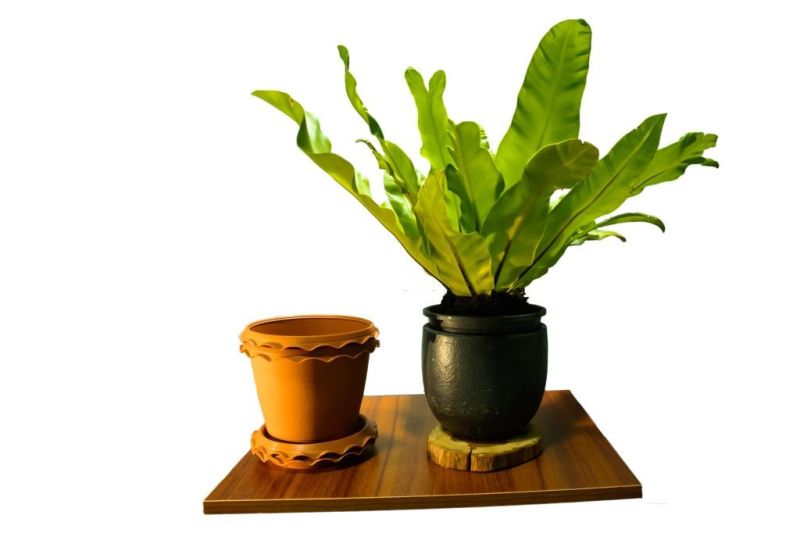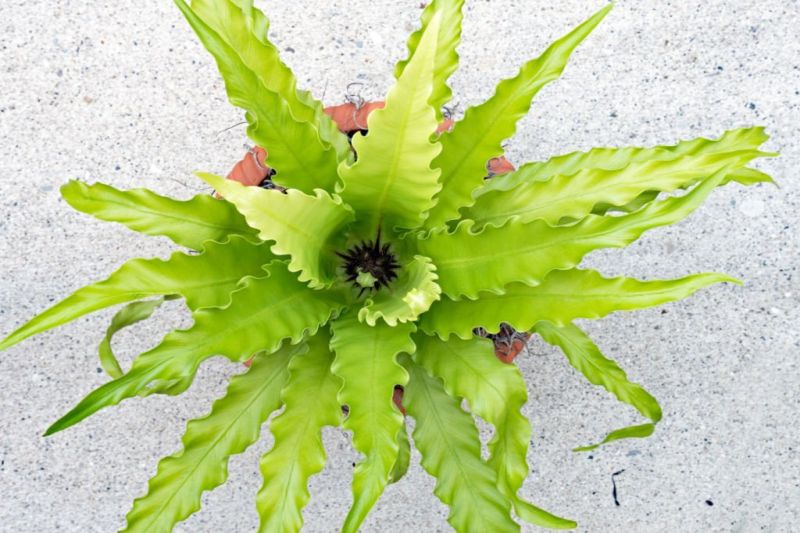Your bird’s nest fern is dying because you are over watering it or exposing it to too much sun light. To fix this problem, reduce the amount of water you give your plant and move it away from the window.
The bird’s nest fern is a beautiful plant that can add some tropical flair to your home. It is an exotic-looking plant with delicately fringed leaves that can be used to create beautiful bouquets or centerpieces.
But if your bird’s nest fern is dying, you might be surprised to learn that there are many causes and ways to revive! In this article we will explore what causes a bird’s nest fern to die, how to prevent it from happening again!
Why is my bird’s nest fern dying?
Your bird’s nest fern could be dying for any number of reasons. Some common causes are:
Over-watering
Over-fertilizing
Too much direct sunlight
Humidity & Temperature
Disease
Pests
Over watering
Watering your bird’s nest fern is a pretty straightforward process, but there are some things to keep in mind. First and foremost, you should only water your plant when the top of the soil has dried out. This is because overwatering can cause root rot, which will kill your fern eventually.
If you wait until the soil starts to feel dry on top before watering again, you’re less likely to accidentally overdo it
You should also make sure that the soil never dries out completely. This is because when the soil dries out, it loses nutrients and moisture, which are important for the growth and health of your bird’s nest fern.
[su_note note_color=”#dcdac2″]Also avoid watering on its nest: This is a very common mistake, and one that many people make without realizing they’re doing anything wrong. But if you water your bird’s nest fern on its nest, you’ll kill it.[/su_note]
Signs of Overwatering
When a bird’s nest fern is over-watered, it will show signs of wilting and drooping leaves. These will turn yellow or brown and eventually fall off altogether. The roots will also be mushy and light in color this means that they’ve probably been sitting in water for too long.
The best way to avoid these problems is by checking for soil moisture daily with your finger you can do this easily by pressing down on the soil or using a moisture meter.
Over Fertilizing
Over-fertilizing can occur if you apply too much fertilizer at one time or use a fertilizer that is too strong for your plant. This can cause the plant’s leaves to turn brown and fall off, which ultimately leads to its death.
The problem with bird’s nest ferns is that they are very sensitive to fertilizer. They only need a small amount of fertilizer each year, and if you give them more than that, it will damage their root system and make them unable to absorb water properly.
Birds nest ferns require only mild liquid fertilizer in the growing season, which is typically spring and summer. During the rest of the year, they need no fertilizer at all.
Too Much Direct Sunlight
Birds’ nest ferns are tropical plants that grow in the wild in the rainforests. These plants are very delicate, and they need to be kept in an environment that mimics their natural rainforest habitat.
To keep your bird’s nest fern alive and thriving, make sure it never gets direct sunlight. If you have one that’s already been out in direct sun for too long, you can try moving it into a spot where it will be shaded by another plant or a piece of furniture.
Signs of Too Much Sunlight
If your bird’s nest fern is beginning to turn brown, it may be getting too much light.
If your plant has recently started looking sickly and discolored, chances are that it’s getting too much sunlight.
Humidity & Temperature
Bird’s nest ferns are tropical plants and need to be kept in an area with high humidity which means they don’t do well in dry environments or with air conditioning. The plant needs at least 50% humidity to thrive.
Temperature fluctuations also can cause your bird’s nest fern to die. The best temperature range for this plant is between 60 and 70 degrees Fahrenheit.
If it gets too hot or too cold for too long, then it will likely start to wilt and die off. If you notice that your plant is wilting because of temperature fluctuations, then move it somewhere where it will get more consistent temperature throughout the day.
Cold Drafts
If your bird’s nest fern is by a window, make sure that the window is not opened too wide or left open during winter months. The cold air and wind can cause the fern to dry out quickly, so it’s best to keep them in an area where they are protected from drafts and won’t freeze easily. If possible, move your plant indoors during this time of year.
If moving your bird’s nest fern can’t be done because you live in an apartment building or don’t have any other place for it to go, you can cover up part of your bird nest fern by using clear plastic wrap so that light still gets through but some heat doesn’t escape either!
Disease
Blight
Bird’s nest ferns are susceptible to bacterial leaf (frond) blight, which is caused by the bacterium Pseudomonas. The disease typically occurs when overhead irrigation and rainfall occurs around some time.
Symptoms of this disease include lesions on leaves that turn brown and develop yellow spots surrounded by brown margins, as well as black or tan areas on leaves that have turned brown due to water damage from overhead irrigation or rainfall.
Bacterial leaf blight can be treated by using an antifungal spray on affected plants. If the infection is caught early enough, it may also be possible to use a systemic fungicide to treat it.
Leaf Spot
This disease is caused by the fungus Cercospora sp., which overwinters on dead leaves or on the soil surface. It spreads from one plant to another during wet weather. The spores germinate on the upper side of young leaves, causing circular lesions that are initially small and brownish yellow but later enlarge and become brownish green, often leaving a dark brown margin around them.
These lesions rapidly spread across the leaf surface, causing it to die and turn brown. Secondary fungi may invade these dead areas, forming dense mats of black, slimy hyphae that eventually cover the entire leaf. As more leaves become infected, they turn brown and may fall off prematurely. In addition to young leaves, older ones may also be affected by this disease if their growing points are damaged by insects such as grasshoppers or mites.
Root Rot
Another most common disease affecting bird’s nest fern is root rot. The plant’s roots are susceptible to root rot when they are overwatered, or if they are planted in poorly drained soil. If you notice the edges of your plant turning yellow, it could be a sign of root rot. This condition can be corrected by watering less frequently and adding more drainage holes to the bottom of your pot.
Pests
The most common pests of birds nest ferns are mealy bugs, which look like white cottony masses and can be found on the underside of leaves. If you find one, apply a pesticide such as horticultural oil or insecticidal soap to the plant and repeat every few weeks until all signs of infestation are gone.
Another potential pest is scale insects: these small brownish insects with hard shells attach themselves to the undersides of leaves and suck out nutrients from the plant’s tissue. They often look like tiny bumps or specks on your bird’s nest fern fronds if you notice any, remove them by hand using tweezers when they’re still small. You can also try spraying your plant with neem oil, it’s safe for use on indoor plants, but be sure not to overdo it because too much could damage your bird’s nest fern’s roots.
Caterpillars are also one of the most common pests that infect bird’s nest ferns. Caterpillars will usually appear in late fall, when they have finished feeding on their host plant and seek out new sources of food. They will often climb onto the trunk or main branches of the plant, where they begin eating away at the leaves. If you see caterpillars on your bird’s nest ferns, there is no need to panic. Simply prune off any damaged or dead leaves, then spray with an insecticidal soap solution or insecticidal oil solution when needed.
To prevent these problems in the future, keep an eye out for any signs that pests might have gotten into your home before hand, if possible vacuum up dust bunnies every week or so this will make it harder for pests like spider mites and use sticky traps outdoors near entryways where pests may find their way into your house through cracks around windows or doors.
Propagating Your Bird’s Nest Fern
Propagation of Bird’s Nest Fern is generaly done through spores.
To start growing your own birds nest fern from spores, you need to collect some healthy spore capsules from adult plants. Once you have collected enough of these spores and sterilized them, place them in moist peat moss that has been placed inside a plastic bag or container with holes punched into it so they will receive adequate humidity during their germination period.
It may take anywhere from 2 weeks up to 6 weeks for the spores to germinate into new plants! Once this happens, remove them from their container and transplant them into individual pots filled with moistened soil mix made for tropical houseplants such as African violet potting mixture or cactus potting mixture; make sure not over water these plants though because overwatering will kill them just like under watering does!
How to care for bird’s nest fern?
If you’re not familiar with the plant, a bird’s nest fern (Asplenium nidus) is a beautiful tropical fern that you can grow indoors or out. It has long, narrow leaves and produces spore capsules on the underside of its leaves. The spores are spread by wind and water, so they’re pretty easy to cultivate.
Bird’s nest ferns do best in bright indirect sunlight but can tolerate low light conditions if they’re given enough time to acclimate. They need moist but well-drained soil that’s high in organic matter. Water them regularly and never let them sit in water after watering them; if you do this, the roots will rot and kill the plant.
Bird’s nest ferns are particularly sensitive to over-watering, so make sure you only water them once per week in spring and summer months and twice per week during fall and winter months when temperatures are cooler outside than they are inside your home or office space where you’re growing these plants.[su_youtube url=”https://www.youtube.com/watch?v=jLYJg5-LEZM” width=”500″ height=”360″]
Conclusion
We hope you enjoyed this blog and that it has helped you to better understand why your bird’s nest fern is dying. If you have any questions, please feel free to leave a comment below.
Also Read: Why Is My Creeping Jenny Dying and How Can I Fix It?

